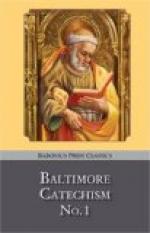During the Mass the priest frequently makes the Sign of the Cross, genuflects or bends the knee before the altar, strikes his breast, etc. What do all these ceremonies mean? By the cross the priest is reminded of the death of Our Lord; he genuflects as an act of humility, and he strikes his breast to show his own unworthiness. You will understand all the ceremonies of the altar if you remember that Our Lord—the King of kings—is present on it, and the priest acts in His presence as the servants in a king’s palace would act when approaching their king or in his presence, showing their respect by bowing, kneeling, etc. You will see this more clearly if you watch the movements of the priest at the altar while the Blessed Sacrament is exposed.
Lesson 23 ON THE END FOR WHICH THE HOLY EUCHARIST WAS INSTITUTED
251 Q. Why did Christ institute the Holy Eucharist? A. Christ instituted the Holy Eucharist:
(1) To unite us to Himself and to nourish our souls
with His divine
life.
(2) To increase sanctifying grace and all the virtues
in our souls. (3) To lessen our evil inclinations.
(4) To be a pledge of everlasting life. (5) To fit
our bodies for a glorious resurrection. (6) To continue
the sacrifice of the Cross in His Church.
“To nourish.” The Holy Eucharist does to our souls what natural food does to our bodies. It strengthens them and makes up for the losses we have sustained by sin, etc. “A pledge,” because it does not seem probable that a person who all during life had been fed and nourished with the sacred body of Our Lord should after death be buried in Hell. “To fit our bodies,” because Our Lord has promised that if we eat His flesh and drink His blood, that is, receive the Holy Eucharist, He will raise us up on the last day, or Day of Judgment. (John 6:55).




